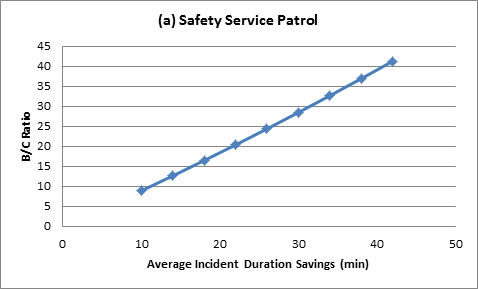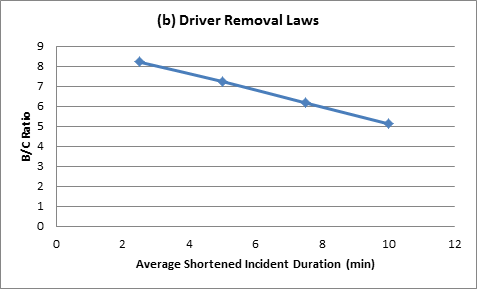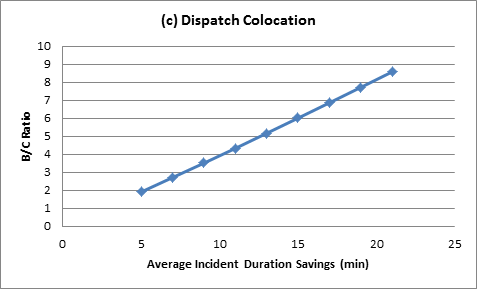U.S. Department of Transportation
Federal Highway Administration
1200 New Jersey Avenue, SE
Washington, DC 20590
202-366-4000
Federal Highway Administration Research and Technology
Coordinating, Developing, and Delivering Highway Transportation Innovations
| REPORT |
| This report is an archived publication and may contain dated technical, contact, and link information |
|
| Publication Number: FHWA-HRT-16-055 Date: January 2016 |
Publication Number: FHWA-HRT-16-055 Date: January 2016 |
A case study performed on the I–95 Corridor Coalition in NY(10) is used to demonstrate the TIM-BC tool application. This study was performed on a 10-mile segment of I–287, beginning at the junction with I–95 and continuing west to the Tappan Zee Bridge in New York.(10) During the 6-month evaluation period, there were 659 incidents on the segment to which only SSP program vehicles responded. This stretch of roadway has 14 ramps and is four-lanes in each direction. The case assumes all level terrain and straight horizontal curvature. The speed limit was assumed to be 65 mph and the traffic volumes are categorized as 1,800 and 1,200 vehicles per hour for AM and PM peak periods with truck percentage of 7.8 percent.
In addition to the SSP program evaluation(12) two other potential TIM programs, DRL and DC, are evaluated and compared with the SSP program. The annual program cost of the SSP program is calculated by the tool based on user input information on the number of patrol vehicles, driver’s hourly wage, working hours, fuel price, and other costs. Users are required to give an overall estimate of annual costs of the other two programs. Herein, a value of $4,000 for this segment is assumed for both programs.
| Strategy | Performance Measure | Safety Service Patrol | Driver Removal Law | Dispatch Collocation |
|---|---|---|---|---|
| Total Program Savings | Travel Delay of Passenger Vehicles | 52,343 Vehicle Hours | 503 Vehicle Hours | 256 Vehicle Hours |
| Travel Delay of Trucks | 1,326 Vehicle Hours | 9.8 Vehicle Hours | 7 Vehicle Hours | |
| Fuel Consumption of Passenger Vehicles | –36 Gallons | 104 Gallons | 143 Gallons | |
| Secondary Incidents | 5.09 | 0.05 | 0.03 | |
| Annual Costs | $161,280 | $4,000 | $4,000 | |
| Emissions Reductions | Hydrocarbon (HC) | –0.0023 Metric Tons | 0.0064 Metric Tons | 0.0089 Metric Tons |
| Carbon Monoxide (CO) | –0.0171 Metric Tons | 0.0481 Metric Tons | 0.0663 Metric Tons | |
| Nitrogen Oxide (NOx) | –0.0011 Metric Tons | 0.0032 Metric Tons | 0.0044 Metric Tons | |
| Carbon Dioxide (CO2) | –0.3683 Metric Tons | 1.0374 Metric Tons | 1.4299 Metric Tons | |
| Sulfur Oxide (SOx) | –0.0059 Grams | 0.0167 Grams | 0.023 Grams | |
| Benefit-Cost Ratio | 18.43 | 7.25 | 3.93 |
As shown in table 12, the SSP program is the most cost-effective strategy with a B/C ratio of 18.43, while the other two strategies have relatively low, but still high ratios at more than 3.0. The results indicate that all three investments are cost effective and should be considered for the segment. Further, with adequate funding for TIM programs, it is recommended that an SSP should be considered first. If their costs, particularly the institutional components, were to be reduced by five times, these two strategies will be comparable with the SSP, and should be considered for implementation.
Sensitivity analyses were conducted with varying values of incident duration savings (0.5–2 times of default values). As shown in figure 18, the B/C ratio increases almost linearly with incident duration savings with similar shallow slopes. Also, the ranking of the three strategies does not change, further illustrating the robustness and reasonableness of the methodology employed in the tool.



Figure 18. Chart. Sensitivity analysis results with varying values for incident duration savings.